I’m writing this as much for my own use as anything else – I keep having to re-invent this solution every time I fix a vintage radio.
Most vintage radios are AM only, and in my part of the world, the only thing on AM is talk radio. Even if that weren’t the case, let’s be honest, most of what people listen to these days is streamed. I don’t like my radios to be shelf-queens, I want to be able to use them and honestly, the sound from the bigger radios is great.
One solution to this is to add an aux-in so that you can plug in an external source and play it through the radio. this certainly works (and you can use most of what is here to do that), but you still need a Bluetooth dongle and leads, and you have to charge it up and turn it on and switch the radio to aux-in. This solution wires the Bluetooth ‘dongle’ into the radio directly, so that it comes on when the radio comes on.
Overview
This shows a high-level view of what we are going to do:
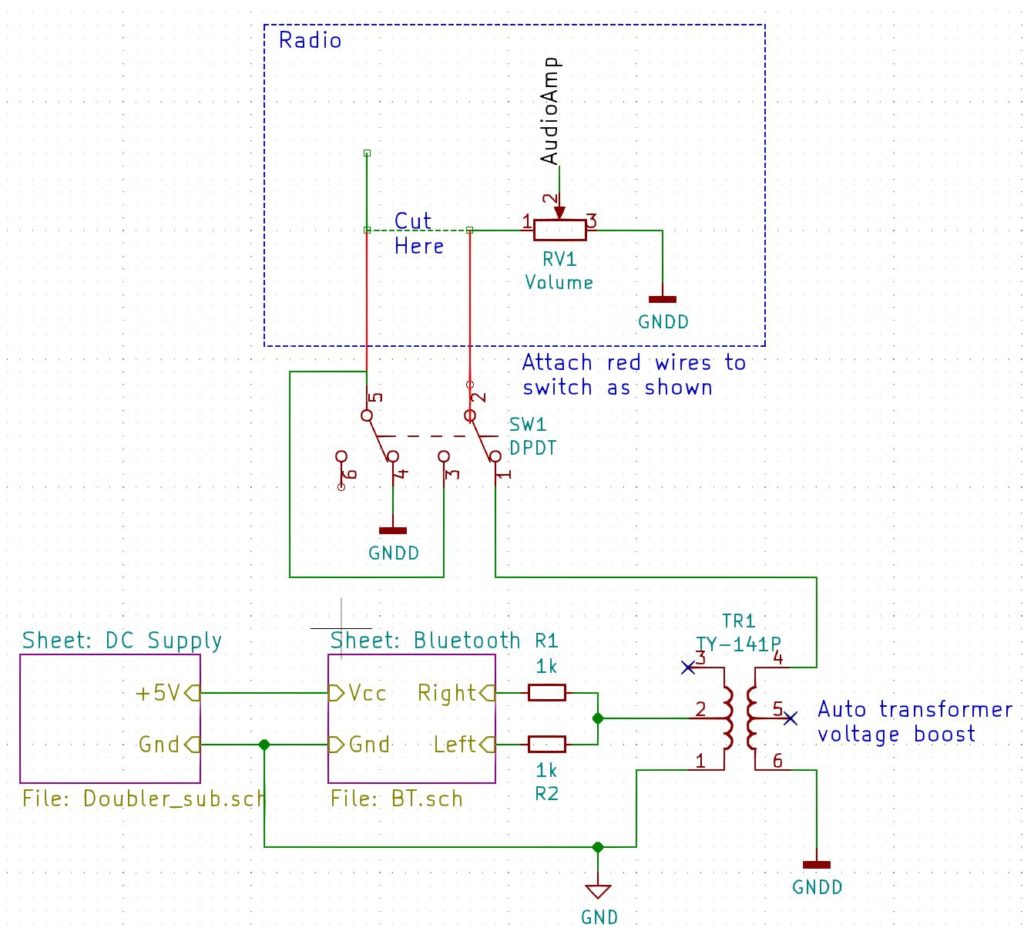
Radio Modifications
Let’s look at the radio block first. The modification here is the same regardless of what external source we are going to wire in. We are going to wire our new audio source across the volume control.
Find the lead going to the volume control that is not connected to ground and does not go to the audio ouput stage. we will cut this wire and route it to a double-pole double-throw switch. A double-pole double-throw switch is simply a switch with two positions (double-throw) that switches two sources at the same time (double-pole). In one position the switch will connect that wire back to the volume control. In the other position it will connect our new audio source instead.
NOTE: It is a good idea to use shielded cable to make the connections between the radio and the switch. Connect the shield to chassis ground.
In the diagram above you can see (hopefully) that when our new audio source is connected, the original one is connected to ground rather than just left floating. This helps stop sound from the RF/IF stages of the radio from bleeding through to the speaker.
Bluetooth Module
The next block to look at as the one marked Bluetooth. You will see that the right and left channels are connected together via two 1k resistors. The use of these resistors prevents the output from one channel destroying the other channel.
Transformer
The next block we will talk about is the auto-transformer. This can serve two purposes.
The first is to boost the output of the Bluetooth module so that it has about the same loudness for a given volume setting as the radio itself. The particular model I am using is the TY-141P. If it is wired as shown in the diagram it gives a 1:2 voltage boost, which seems about right on all the radios I have modded. Triad make another transformer – the TY-142P that can give a boost of 1:2.24 or 1:4.48 depending on how it is wired.
The second purpose is that it can act as an isolation transformer to decouple the new audio source from the radio. This can help to remove ground-loop hum that can arise depending on how the new source is powered. In some scenarios, the chassis ground (GNDD) may be the same as the power supply ground (GND).
NOTE: The point that the auto-transformer is connected to chassis ground can be important. I have found that if you connect it to the volume ground terminal, you will hear hash from the Bluetooth receiver when listening to broadcasts. Experiment with different locations. If all else fails, use a three-pole double-throw switch to disconnect the power to the Bluetooth unit when listening to broadcasts.
Bluetooth Module Details
My preferred Bluetooth module is the KRC-86B, pictured below:
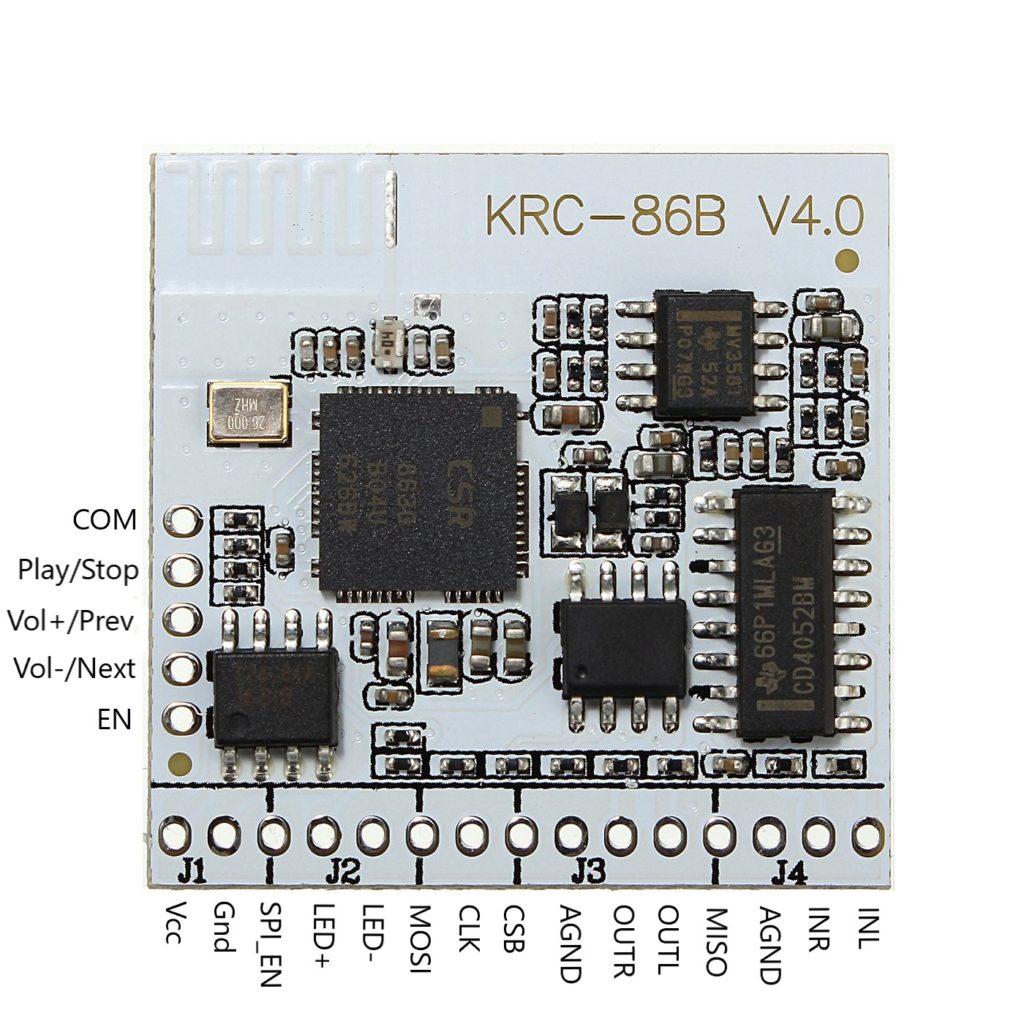
There are a lot of possible connections that we aren’t going to use. We are just going to provide it with a Vcc of +5V and use OUTL and OUTR like so:
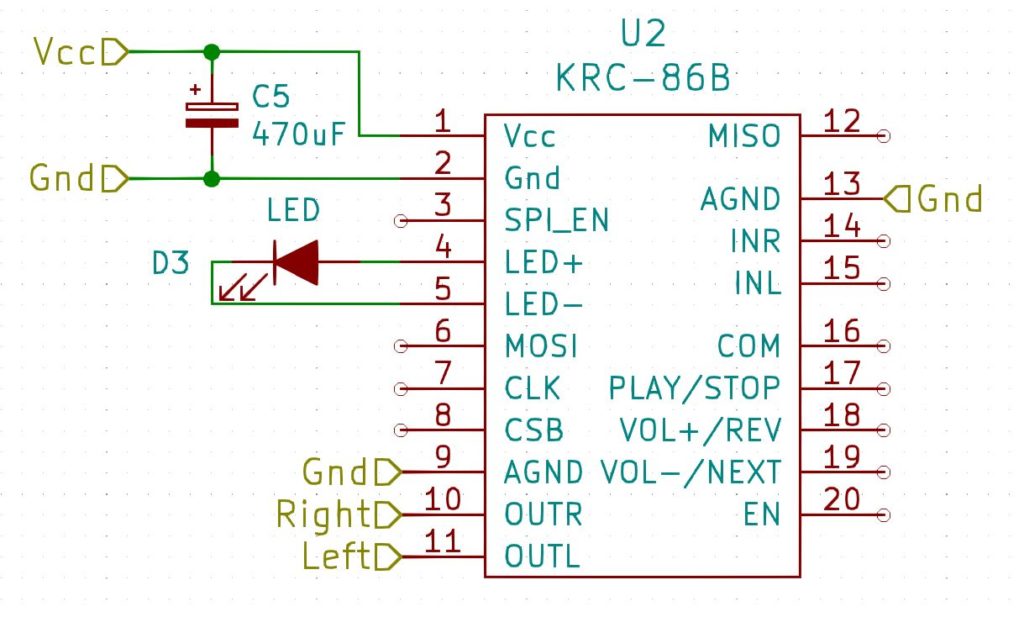
The LED indicates the state of the module. If it is connected it will be steady. If it is not connected it will be flashing, and if there is no power, it will be off! The capacitor is just a decoupling capacitor. Both of these are normally provided with the module.
Power Supply Details
The KRC-86B needs 3.7V to 5V. You could provide this with a battery pack or an external 5V supply and you could wire this power source in to the switch so that it only powered the module when it was selected as an input, but you would need a three-pole double-throw switch to do that.
The module only draws at most 80mA, so let’s see if we can provide that directly from the radio. We will probably need to convert some AC voltage into a DC voltage. Some radios have a transformer that provides the filament voltage, and these are probably the cleanest way to power the device. We can just convert the 6.3V AC into 5V DC. Another alternative I have used is to connect my power supply in parallel with the filament of a vacuum tube.
The basic idea is to rectify the AC, smooth it and then feed this through a 5V voltage regulator. 8V-12V is ideal for using a bridge rectifier, however 6.3V won’t provide a high enough rectified and smoothed voltage to feed a 5V voltage regulator, so in this case we need to use a voltage doubler as in the circuit below:

Here’s what it looks like. In this case, there was a handy post I can screw it to:
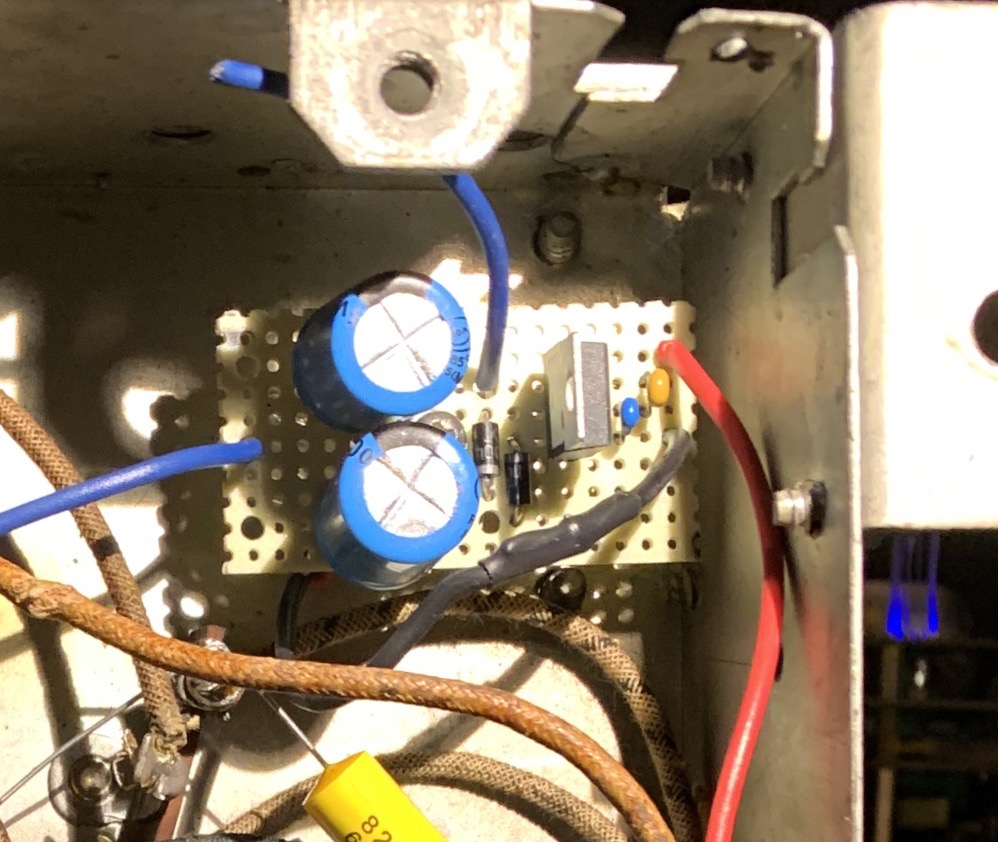
This is what it looks like underneath:
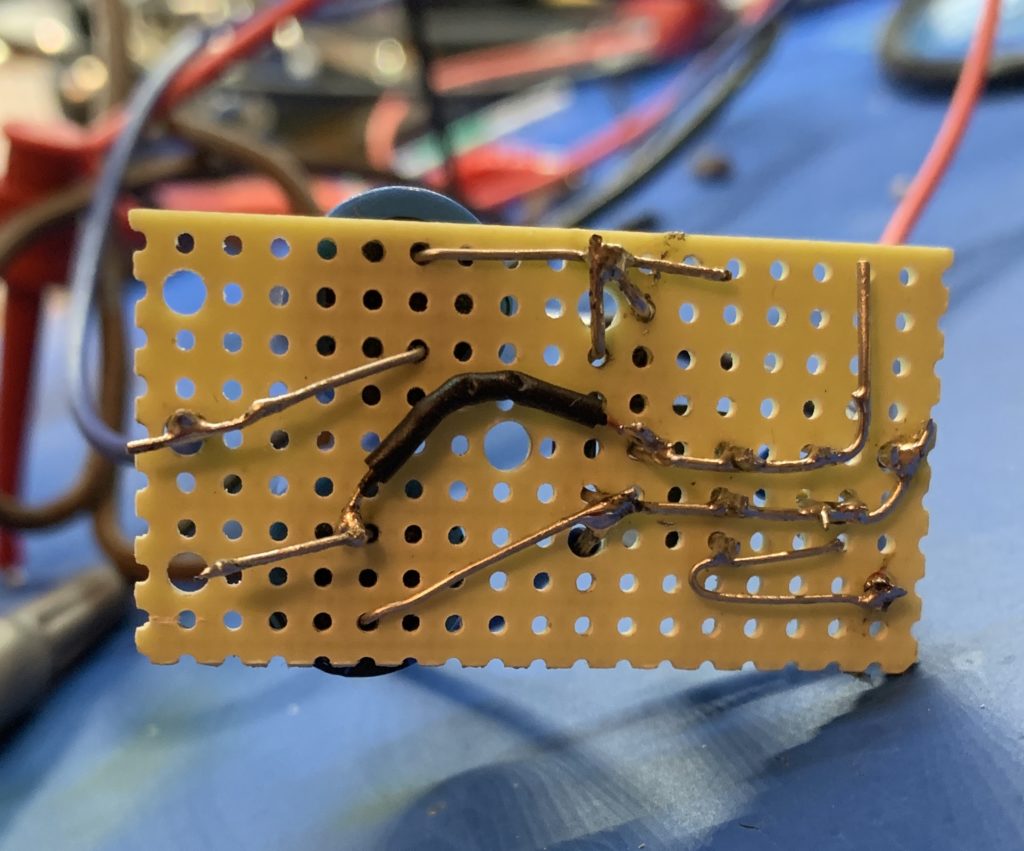
Finally, here is what the module, switch and auto-transformer look like in one of the radios I modded. In this case the switch was already there from a mod that had been made in the dim and distant past:
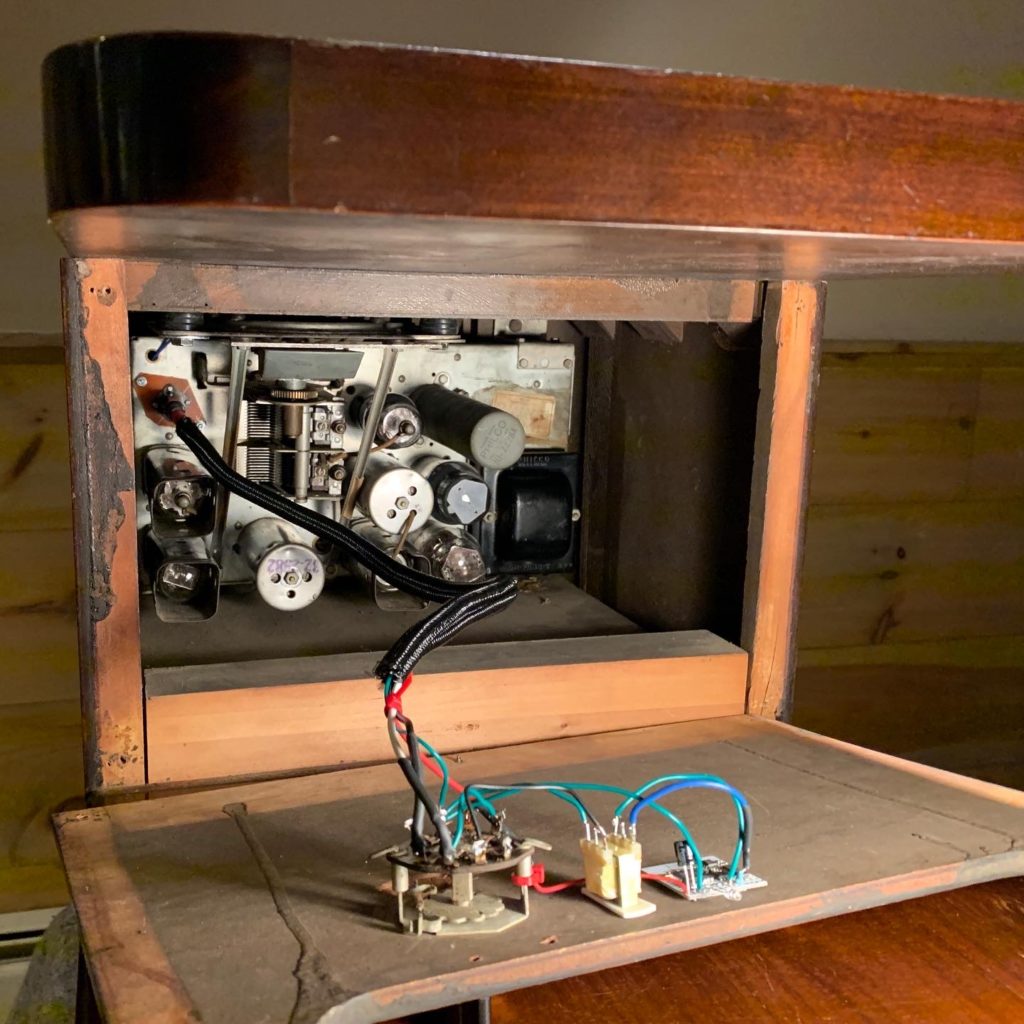
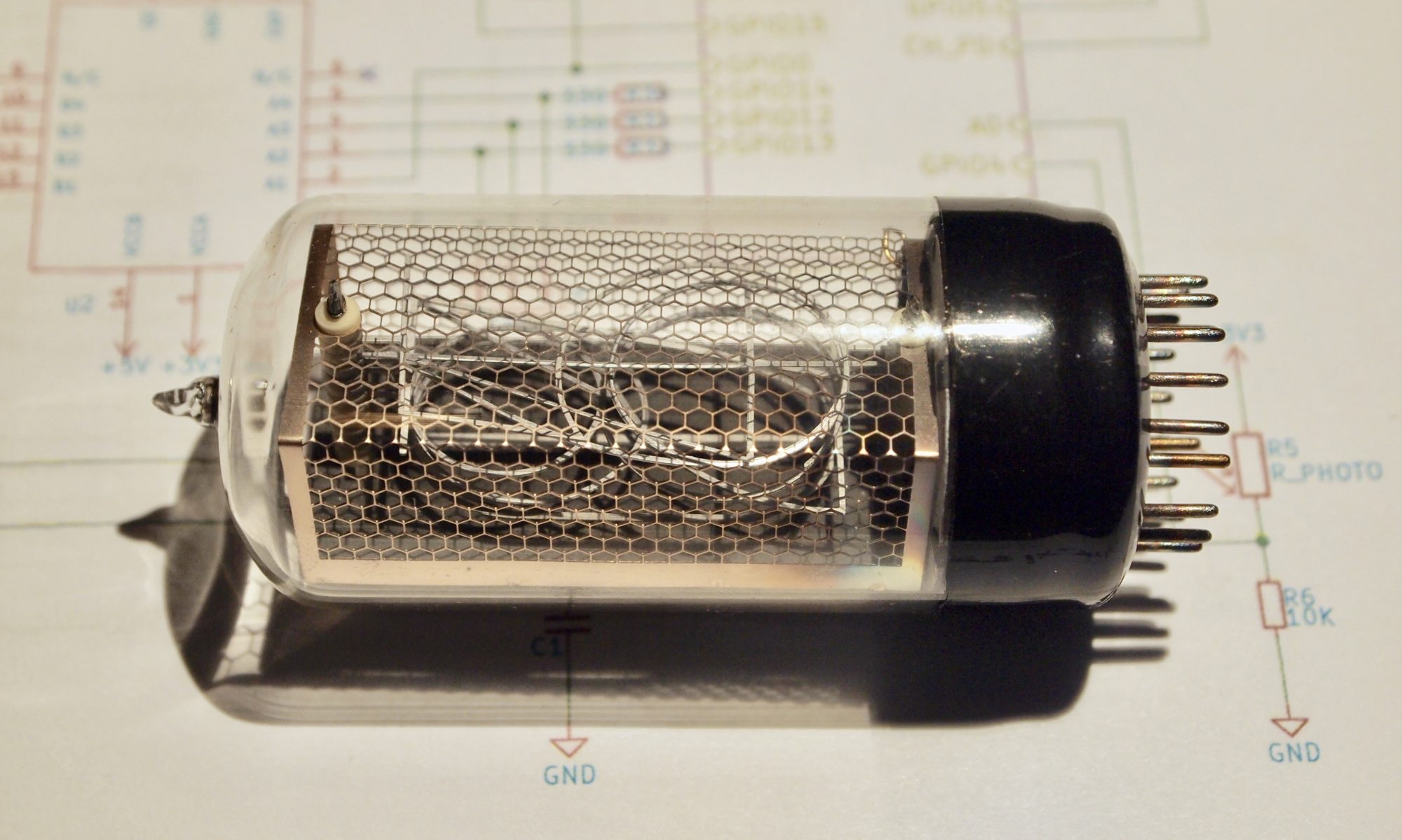
With regards to hum pick up – you can manage without the transformer, but you need to take measures to deal with the ground loop between the input supply and the audio connection to the radio. Because one end of the filament winding is connected to chassis, the loop is inevitable, and if you do nothing then induced mains hum will produce voltage fairly evenly distributed around the loop. That means there is a hum voltage between the Bluetooth chip ground and the audio input to the radio.
To prevent this, you need to add a small value resistor in the ground loop before the BT module after C4 – say 10ohms or less possibly (the hum is attenuated by the ratio of R to the connection resistance, which is a few mohms). That means all the hum pickup is between the psu input and the BT chip, and then at the output side, the BT chip and the audio connection have no hum voltage present. I have used this with the same module to good effect. As an additional measure, you can put a small value capacitor across the resistor to improve the impedance of the supply to the BT circuits, but I have not found this to be necessary.
I have been working on tube radios and have added Bluetooth, FM, and Aux connections. I have to say your article covers it all, really appreciate you posting it.
This article really does covers it all, I just have a question as I am a little confused on the schematic you drew and the actual final picture.
You show the transformer connections in the schematic in one way but then in the final picture seems you followed a different wiring.
In the schematic you showed the mono signal going in at pin #2 but on the final picture it looks like you placed that at pin#3
Why is that?
In this case I just didn’t need the 1:2 step up.
Planning to put a Bluetooth module in a National SW-64 which is a fully metal case, do you think it will block the signal? Does this module support an external antenna? Thanks!
I would have the same concerns. This module doesn’t allow an external antenna. They’re pretty cheap, so you could just power one up inside the case and see what happens.
I have a 1969 Crown SHC-55 all in one music center.
It has FM/AM radio, Garrard 2025 turntable, And cassette deck with right and left microphones record In stereo.
There are no audio auxiliary inputs on the back panel. Just speaker outputs which are the rca type.
I would really like to add Bluetooth capability to my stereo however I don’t know how to.
This stereo has been in my family since we purchased it new back in 1969 so it has a lot of sentimental value. It would be so great if there is a way to modernize it with Bluetooth capability.
Recently I took it to an audio repairman to have it serviced. I asked if Bluetooth can be added. He thought maybe the left and right microphone jacks could act as an aux input however it turned out that they only operate when the cassette deck is recording. Once that didn’t pan out he declined looking into it any further.
I’m willing to pay someone who knows how to do it. I watched a few YouTube videos on the subject. One shows how to tapp into the volume potentiometer and added a switch and Bluetooth module. Unfortunately I don’t have the necessary skills to do it myself.
If anyone knows of a good technician I would really appreciate it.
My advice would be to find a local vintage electronics club. For example, in New England we have https://nevec.groups.io/g/main